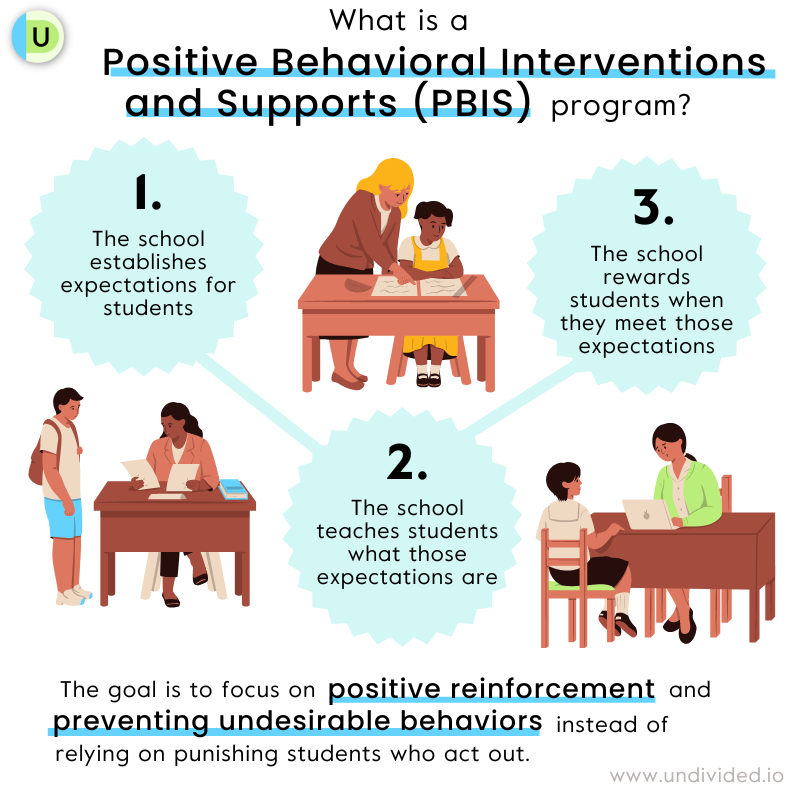Positive Behavioral Interventions and Supports (PBIS) 101
A Positive Behavioral Interventions and Supports (PBIS) program is often used in schools to help encourage good student behavior. Here’s a breakdown of what one might look like, how it can best support students, and how to work with the school to make sure such an initiative benefits your child.
What is PBIS?
PBIS involves establishing expectations for students, teaching students what those expectations are, and rewarding them when they meet those expectations to build a positive reinforcement system. Because students benefit from consistency, PBIS is implemented throughout an entire school rather than in only one classroom. According to Barbara Kelly, founding member of the California Technical Assistance Center on PBIS, “PBIS shifts thinking from blaming the child for behavior to blaming the environment, and focuses on changing a child’s environment so they can be successful. Teachers using PBIS are receiving a primer in behavior science.”
In practice, this often looks like a school choosing three to five values — such as respect, responsibility, and hard work — and rewarding students when their behavior aligns with those values. For example, a school might have a program called “Wildcat Wows” where teachers can reward student behavior by handing out paper ticket "wows" to later be redeemed for specific rewards or recognition.
Why do schools use PBIS?
PBIS is a tool used by schools to help them improve the effectiveness, efficiency, and equity of their educational environment. The goal is to focus on positive reinforcement and prevent undesirable behaviors instead of relying on punishing students who act out. Research shows that this approach helps improve social, emotional, and academic outcomes for all students, including students with disabilities and students from underrepresented groups.
First developed by researchers from the University of Oregon, PBIS has been endorsed by the US Department of Education as an evidence-based program. In studies, it has been shown to:
- Reduce bullying behaviors
- Reduce expulsion
- Reduce restraint and seclusion
- Increase social and academic performance for students with disabilities
Although PBIS has its roots in programs developed to address behavior disorders (it is mentioned in IDEA and supported in the Every Student Succeeds Act in 2015), it’s not only for students with disabilities.
The PBIS framework includes three tiers:
Universal supports for all children, which should benefit the majority of students;
Supports for students who aren’t successful with tier one alone;
Intensive supports for students who have higher needs.
Barbara Kelly says, “One example of how this works is the ‘check-in/check-out’ system, where a child will check in with a member of school staff at the beginning and check out at the end of the day. During this time, they learn how to self-monitor their behavior with teacher support to reach their goals.”
Supporting students who have higher needs might look like:
- checking in more often
- implementing specific social skills instruction, such as a class or period of time set aside for this
- pulling in outside agencies and professionals to increase the level of support
How can PBIS be more inclusive?
A school’s PBIS program might incorporate tokens or points that students can earn and exchange for rewards, like a tangible prize or extra privileges. Bonuses and teacher praise are extrinsic rewards, meaning they reinforce positive behavior from an outside source. On the other hand, intrinsic rewards come from within the student, such as feeling the satisfaction of a job well done or the desire to learn and master a new skill.
Barbara Kelly explains, “Extrinsic rewards, such as stars, are great for acknowledging a preferred behavior and building excitement, but you have to build intrinsic motivation at the same time, or they may not be able to maintain the behavior on their own.” Kids should understand why they earn a token, such as showing respect for their peers or upholding another school-wide value.
PBIS programs tend to focus on extrinsic rewards like tickets and tokens for positive behavior, but according to Licensed Clinical Social Worker Laura Mooiman, “The main point is that you want to have those moments where kids feel seen and acknowledged and heard for their efforts.”
Since PBIS is a framework for reinforcing behavior rather than a one-size-fits-all method, it should help teachers adapt to their students’ responses. For example, what if a kid doesn’t want to be recognized in front of their peers? Laura Mooiman says that schools can conduct surveys among their students to find out how they prefer to be acknowledged. Some kids turn down physical prizes but highly value social rewards, like sitting close to the teacher or getting to choose music for the class at lunchtime.
Does PBIS have any risks?
It’s important to know that the extrinsic reward system can occasionally develop a dark side. For example, teachers and paraprofessionals might engage in weaponizing rewards by threatening to take them away. A teacher might say, “I would have given you three ‘wows’ today because of the three good things that happened this morning, but now you are in so much trouble after lunch, so I am taking those away.” Rewards earned should never be withdrawn because they then become punishments. Punishments are not a feature of an effective PBIS program.
Jean Gonsier-Gerdin, a professor in the special education department at CSU Sacramento, said that when a reward system isn’t working for a particular student to reduce problem behavior, a functional behavior assessment (FBA) can help the teacher determine why inappropriate behavior is continuing. She says, “We need to understand what changes we might need to make to the environment to make it less likely that the student is going to have the negative behavior and more likely that they're going to have the positive behavior.” This might look like teaching the student how to ask for a break appropriately, for example, or figuring out whether a different intervention or reward is more reinforcing.
In the clip below, Dr. Caitlin Solone explains what a more inclusive classroom can look like when it comes to behavior:
How can you tell if a school is using PBIS?
Talking with teachers and other school leadership can help you assess how the school is implementing PBIS and the impact it has on students. You can also learn who is responsible for implementing the PBIS initiative.
Here are some questions you could ask the staff:
- How does the school share its expectations and rewards with students and their families?
- What kinds of tokens are used? What kinds of rewards do the tokens purchase?
- Are different rewards available for kids?
Barbara Kelly recommends that parents ask to see the school’s data regarding behavior, attendance, and academics to understand how a PBIS initiative is affecting the school’s environment. She says, “For example, if 48 out of 50 kids of a particular race are receiving referrals to the principal for discipline, then the environment needs to be corrected to ensure that all their students are being taught and treated with equity.”
Laura Mooiman says that schools with a good PBIS system should be collecting data on where problem behaviors happen, what time of day they happen, and who is involved. This way, teachers and administrators can look at what leads to the behaviors and identify what intervention would be appropriate for the situation.
How can you communicate your concerns to the school?
Ideally, there will be a school leader for PBIS, or there might be a Climate/Culture Team or Tier One Team. If not, talk to the principal or a school board member about implementing a PBIS initiative or improving the one already in place. If you’re concerned about discipline or intervention at your child’s school, you can share resources from the California PBIS Coalition and the Center on PBIS. Laura Mooiman emphasizes that parent involvement can help in making sure schools have the training and funding to make PBIS programs successful and inclusive for all students.
To learn more about PBIS and get involved at your school, check out this helpful resource sheet for parents from CalTAC-PBIS.
Request an Individualized Education Program (IEP) meeting
Join for free
Save your favorite resources and access a custom Roadmap.
Get StartedAuthor



